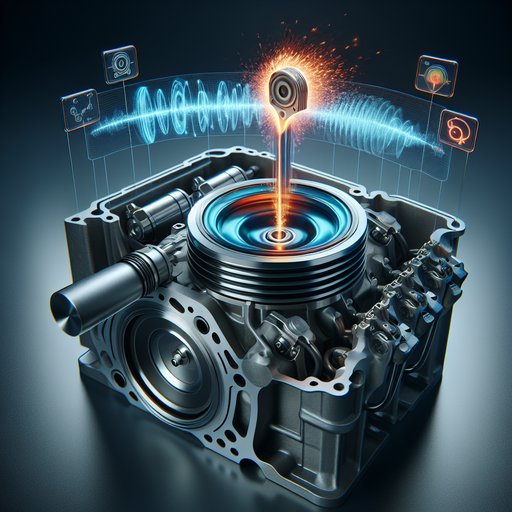
Gasoline spark‑ignition engines face three distinct abnormal combustion modes. Detonation (often called knock) is end‑gas auto‑ignition after the spark, creating high‑frequency pressure ringing. Pre‑ignition starts the burn before the spark due to a hot spot, leading to extreme pressure rise. Low‑Speed Pre‑Ignition (LSPI) is a sporadic, severe pre‑ignition seen in boosted, direct‑injection engines at low rpm/high load. Modern controls—block‑mounted knock sensors, ion‑sensing through the spark plug, and closed‑loop spark/boost/fueling—keep operation near the knock limit while steering clear of LSPI. The result is consistent torque across fuels (AKI 87–93), with efficiency preserved by running close to MBT timing when safe.
Detonation/knock, pre‑ignition, and LSPI are often conflated, but they differ in timing and mechanism. Knock is auto‑ignition of the end‑gas that occurs after the commanded spark initiates the main flame. It generates pressure oscillations in the 5–15 kHz range (for 80–100 mm bores) and erodes components if sustained. Pre‑ignition happens before the spark, so the mixture is already burning at or before the ignition command; it produces a very rapid pressure rise.
LSPI is a pre‑ignition subtype typical of turbocharged, gasoline direct‑injection (GDI) engines at 1200–2500 rpm and high BMEP, often leading to “super‑knock” with damaging peak pressures. The control philosophy is: operate as close as practical to knock‑limited optimal timing (MBT) for efficiency, detect incipient knock and back off a few crank degrees, and avoid operating points and conditions that trigger pre‑ignition/LSPI. That requires fast sensing, per‑cylinder adaptation, and calibrated limits on boost, lambda, and injection phasing at low speed. Hardware, oil/fuel chemistry, and combustion phasing all contribute; no single lever prevents all three phenomena.
Mechanistically, knock arises when the end‑gas reaches auto‑ignition conditions due to combined effects of compression ratio, charge temperature, residuals/EGR, and boost. Typical boosted SI engines run 9.5–11.0:1 compression, λ ≈ 0.85–0.95 at high load for charge cooling, and intake air temperatures can exceed 50–70 °C in hot ambient despite intercooling. The end‑gas may reach 800–900 K before flame arrival; if its auto‑ignition delay is shorter than the remaining combustion time, it lights off, sending pressure waves through the chamber. Knock limits spark advance and boost; on AKI 87 versus 93, the same engine may need 4–7° less advance at mid‑load or ~0.2–0.4 bar less manifold pressure to avoid knock.
Pre‑ignition differs because the source is a hot spot or local ignition kernel unrelated to the spark command—glowing deposits, overheated electrodes, sharp edges, or oil/fuel droplets. With the piston still rising, the pressure rise rate can exceed 20–50 bar/ms, spiking peak cylinder pressures above 150–200 bar within a cycle, enough to crack ring lands or break spark plugs. LSPI is a particular risk in boosted GDI at low speed/high load: long residence time, high in‑cylinder pressure, and wall/oil interaction create reactive droplets. Contributing factors include late injection that wets the top land, volatile oil/fuel fractions from the PCV stream, and some detergent chemistries.
Calibrations show LSPI event rates dropping by >50–80% when switching from calcium‑dominant to magnesium‑dominant detergent packages and by similar margins with reduced top‑land crevice volume and earlier/dual injection strategies. Sensing and control are layered. Wide‑band knock sensors (piezoelectric accelerometers) detect block resonance at the knock frequency; ECUs band‑pass the signal per cylinder and per gear/load to estimate intensity. Closed‑loop spark trims typically pull 2–3° on a knock hit, then creep back in 0.25–0.5° steps to ride the limit; enrichment (e.g., λ from 0.95 to 0.88) or boost reduction can be commanded if repeated events occur.
An “octane learn” scalar adapts long‑term timing to fuel quality and intake temperature, maintaining torque across AKI 87–93. Ion‑sensing coils apply a bias across the plug after (and slightly before) the spark; the ion current waveform reveals combustion phasing and knock onset, enabling even faster, per‑cycle adjustments and misfire discrimination. Crucially, pre‑ignition/LSPI can be seen as ion current before the commanded spark or as abnormal pressure rise; when detected, the ECU aborts torque: immediate fuel cut for that cylinder, throttle/wastegate opening, and timing retard on neighbors to prevent cascading damage. Additional LSPI mitigation includes: limiting boost below ~2000 rpm, targeting λ ≈ 0.92–0.98 instead of very rich or very lean, early/multi‑pulse injection to minimize wall wetting, cooled EGR to lower end‑gas temperatures, PCV flow control, and specified low‑volatility oils.
In practice, these strategies protect reliability by keeping pressure rise and peak pressure within component limits, cutting the frequency of super‑knock that fractures ring lands or damages bearings. Emissions trade‑offs are real: enrichment for knock control raises CO/HC and particulates, while EGR and boost limits can reduce NOx but may dull transient response. Hardware (sensors, ion‑sense ignition, robust pistons) and calibration add cost, yet closed‑loop control delivers consistent real‑world drivability: smooth torque across fuels and climates, brief and often unnoticeable torque clipping at low‑speed/high‑load to avoid LSPI, and near‑MBT efficiency during cruise where compression ratios (10–11:1) and λ ≈ 1.00 can be safely maintained.








